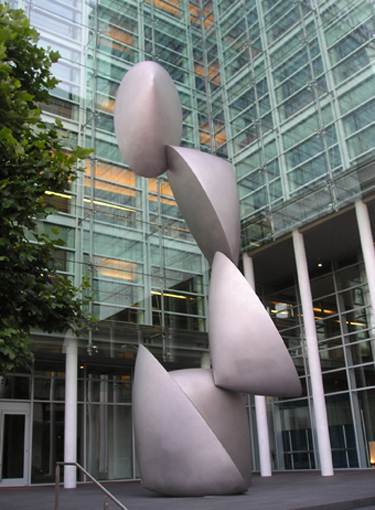Artist:
Richard Deutsch
Title:
Time Signature
Year:
2008
Adress:
Foundry Square
www.richarddeutsch.com:
Time Signature, a landmark sculpture at the major urban intersection of First and Howard streets, commemorates a site that has a rich industrial history of metal foundries, fundamental to the building of San Francisco. Early forging tools influenced the imagery of Time Signature. In particular, the crucible — which holds metal as it transforms into its molten state — provides inspiration for the sculpture’s form.
Richard Deutsch developed the concept for Time Signature to distinguish this historic urban site through an inspired marriage of art and architecture. Four glass buildings that define the corners of First and Howard streets unify as one architectural concept through their geometry, materials, location, and artistic philosophy. Set against the 100-foot-tall vertical glass facade of south facing Building One, Time Signature juxtaposes five curved stainless steel vessels that soar to 48 feet. Sensitive to the elements of light, translucency, and reflection, Time Signature is activated as it responds to the changes in time of day and season.
Time Signature is a luminary and theatrical place marker contributing to the dynamic San Francisco cityscape. Utilizing high-tech stainless steel and modern fabrication technology, Time Signature stands as a meaningful symbol honoring San Francisco’s industrial past while inspiring its future.
www.performancestructures.com:
San Francisco Bay Area artist Richard Deutsch approached Performance Structures to realize his vision for a monumental sculpture in San Francisco's Foundry Square.
Time Signature rises nearly fifty feet above the pavement before 400 Howard Street's glass and steel facade. Five stainless steel 'pod' forms, inspired by the shape of a centuries-old crucible, are stacked vertically, secured to an internal mast structure by a network of precision-tensioned steel cables.
In the event of an earthquake, the pods are able to flex relative to each other, so that their smooth surfaces do not buckle. Stainless steel, with a semi-matte textured surface.
www.artandarchitecture-sf.com:
Richard Deutsch wanted to use a light colored metal for the reflective properties and to interact with the glass. The area that the sculpture is in is called Foundry Square. Crucibles, a vital part of metal pouring, were the shapes that inspired Deutsch.
Richard Deutsch was further inspired by music and was setting a tempo for a musical composition, attempting some sort of lyrical movement.
Time Signature, a landmark sculpture at the major urban intersection of First and Howard streets, commemorates a site that has a rich industrial history of metal foundries, fundamental to the building of San Francisco. Early forging tools influenced the imagery of Time Signature. In particular, the crucible — which holds metal as it transforms into its molten state — provides inspiration for the sculpture’s form.
Richard Deutsch developed the concept for Time Signature to distinguish this historic urban site through an inspired marriage of art and architecture. Four glass buildings that define the corners of First and Howard streets unify as one architectural concept through their geometry, materials, location, and artistic philosophy. Set against the 100-foot-tall vertical glass facade of south facing Building One, Time Signature juxtaposes five curved stainless steel vessels that soar to 48 feet. Sensitive to the elements of light, translucency, and reflection, Time Signature is activated as it responds to the changes in time of day and season.
Time Signature is a luminary and theatrical place marker contributing to the dynamic San Francisco cityscape. Utilizing high-tech stainless steel and modern fabrication technology, Time Signature stands as a meaningful symbol honoring San Francisco’s industrial past while inspiring its future.
www.performancestructures.com:
San Francisco Bay Area artist Richard Deutsch approached Performance Structures to realize his vision for a monumental sculpture in San Francisco's Foundry Square.
Time Signature rises nearly fifty feet above the pavement before 400 Howard Street's glass and steel facade. Five stainless steel 'pod' forms, inspired by the shape of a centuries-old crucible, are stacked vertically, secured to an internal mast structure by a network of precision-tensioned steel cables.
In the event of an earthquake, the pods are able to flex relative to each other, so that their smooth surfaces do not buckle. Stainless steel, with a semi-matte textured surface.
www.artandarchitecture-sf.com:
Richard Deutsch wanted to use a light colored metal for the reflective properties and to interact with the glass. The area that the sculpture is in is called Foundry Square. Crucibles, a vital part of metal pouring, were the shapes that inspired Deutsch.
Richard Deutsch was further inspired by music and was setting a tempo for a musical composition, attempting some sort of lyrical movement.



